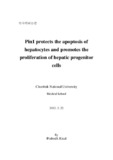Please use this identifier to cite or link to this item:
http://archive.nnl.gov.np:8080/handle/123456789/322| Title: | Pin 1 protects theapoptosis of hepatocytes and promotes the proliferation of hepatic progenitor cells |
| Authors: | Risal, Prabodh |
| Keywords: | Acute liver injury Apoptosis CCI4 Liver necrosis NF-kB Peptidyl-prolyl isomerase Pin 1 DDC diet Oval cell proliferation |
| Issue Date: | 1-Jun-2018 |
| Abstract: | Pin1, a member of parvulin family of PPIase enzyme plays a crucial role in the post-phosphorylation regulation that governs important role in the cell signaling mechanism. Pin1 specifically catalyzes the isomerization of peptidyl prolyl bond and regulates the function of its target proteins. It was assumed that, Pin1 may play a critical role in hepatocytes and hepatic progenitor cells (oval cells). This finding could help to understand the biology of hepatocyte and oval cell during liver injury. To understand the role of Pin1 in the liver injury, mice were injected with Pin1 adenoviruses (ad-Pin1) and with carbon tetrachloride (CCl4). Chronic liver injury and oval cell activation model was also established by feeding the mice with 3, 5-diethoxycarbonyl-1, 4-dihydrocollidine (DDC) diet. AML12 hepatocyte cells treated with CCl4 and TGF-β showed a decrease in Pin1 level. Similarly, when Pin1 was inhibited by Juglone, a chemical inhibitor, and treated with TGF-β, cell viability decreased significantly. When Pin1 was over expressed using ad-Pin1, and treated with TGF-β, cell viability increased compared to LacZ overexpressed cells. When Pin1 was overexpressed in the liver and acute liver injury was induced, reduced apoptosis and liver necrosis was observed. The expression of CYP2E1 enzyme as well as TNF-α were not changed, but NF-κB DNA binding was increased by Pin1 overexpression. In the chronic liver injury model, oval cells expansion and increased Pin1 expression in the liver was observed. Pin1 along with A6, CD44, PCNA and β-catenin were positive in the oval cells. In western blot analysis, cultured oval cells showed higher expression of Pin1 in compare to the hepatocytes and, upon treatment with TGF- β, Pin1 protein was not reduced as in the hepatocytes. Oval cells stimulated with IGF-1, showed increased Pin1 in a time dependent manner, along with β-catenin, and proliferating cell nuclear antigen (PCNA), reflecting the progression of cell cycle. Further, knockdown of Pin1 with siRNA in oval cells reduced its proliferation significantly. In conclusion, Pin1 plays a critical role in different cell population of the liver especially by protecting apoptosis of hepatoyctes in case of acute liver injury and by proliferating hepatic progenitor cells during chronic liver injury. |
| Description: | Thesis submitted for the partial fulfillment of Ph.D, Chonbuk National University, Medical School, 2011. |
| URI: | http://103.69.125.248:8080/xmlui/handle/123456789/322 |
| Appears in Collections: | 500 Natural sciences and mathematics |
Files in This Item:
| File | Description | Size | Format | |
|---|---|---|---|---|
| 68- Dr. Prabodh Risal.pdf | 2.7 MB | Adobe PDF |  View/Open |
Items in DSpace are protected by copyright, with all rights reserved, unless otherwise indicated.